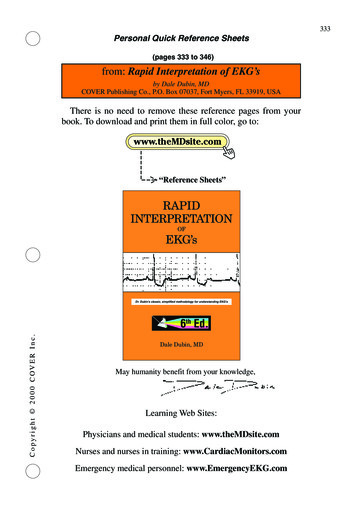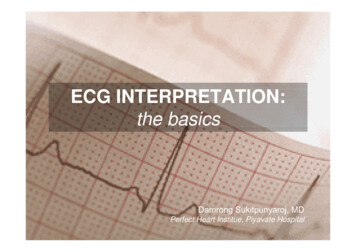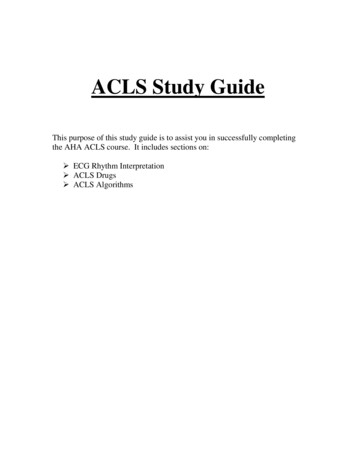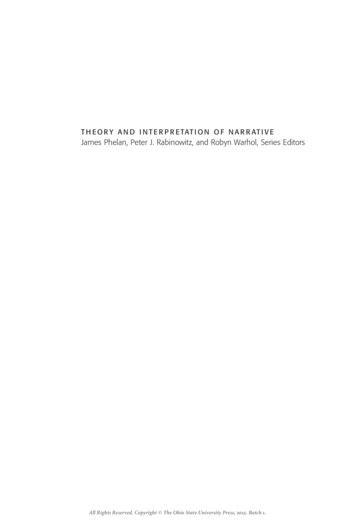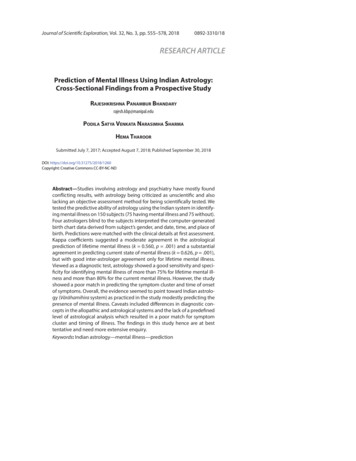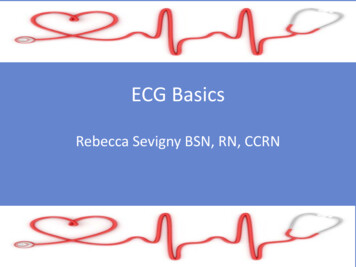
Transcription
Interpretation
PROFESSIONAL INTERPRETING IN THE REAL WORLDSeries Editor: Diane Teichman, Linguistic Services, Houston, Texas, USAThis series will publish books ranging from resource texts which help both interpretersin training and practising interpreters to better prepare for their assignments, totraining materials and instruction manuals for instructors of interpreters.Other Books in the SeriesThe Interpreter's Guide to the Vehicular Accident LawsuitJosef F. BuenkerOther Books of InterestCulture Bumps: An Empirical Approach to the Translation of AllusionsRitva LeppihalmeConstructing Cultures: Essays on Literary TranslationSusan Bassnett and André LefevereThe Pragmatics of TranslationLeo Hickey (ed.)Practical Guide for Translators (3rd edition)Geoffrey Samuelsson-BrownWritten in the Language of the Scottish NationJohn Corbett‘Behind Inverted Commas’ Translation and Anglo-German Cultural Relations in theNineteenth CenturySusanne StarkThe Rewriting of Njßls Saga: Translation, Ideology, and Icelandic SagasJón Karl HelgasonTime Sharing on Stage: Drama Translation in Theatre and SocietySirkku AaltonenTranslation and Nation: A Cultural Politics of EnglishnessRoger Ellis and Liz Oakley-Brown (eds)The Interpreter’s ResourceMary PhelanAnnotated Texts for Translation: English–GermanChristina Schäffner with Uwe WiesemannContemporary Translation Theories (2nd Edition)Edwin GentzlerLiterary Translation: A Practical GuideClifford E. LandersTranslation-mediated Communication in a Digital WorldMinako O’Hagan and David AshworthFrae Ither Tongues: Essays on Modern Translations into ScottsBill Findlay (ed.)Practical Guide for Translators (4th edition)Geoffrey Samuelsson-BrownCultural Encounters in Translation from ArabicSaid Faiq (ed.)For more details of these or any other of our publications, please contact:Multilingual Matters, Frankfurt Lodge, Clevedon Hall,Victoria Road, Clevedon, BS21 7HH, Englandhttp://www.multilingual-matters.com
PROFESSIONAL INTERPRETING IN THE REAL WORLDSeries Editor: Diane TeichmanLinguistic Services, Houston, Texas, USAInterpretationTechniques and ExercisesJames NolanMULTILINGUAL MATTERS LTDClevedon Buffalo Toronto
Library of Congress Cataloging in Publication DataNolan, JamesInterpretation: Techniques and Exercises/James Nolan.Professional Interpreting in the Real WorldIncludes bibliographical references.1. Translating and interpreting. I. Title. II. Series.P306.N586 2005418'.02–dc222004016745British Library Cataloguing in Publication DataA catalogue entry for this book is available from the British Library.ISBN 1-85359-791-0 (hbk)ISBN 1-85359-790-2 (pbk)Multilingual Matters LtdUK: Frankfurt Lodge, Clevedon Hall, Victoria Road, Clevedon BS21 7HH.USA: UTP, 2250 Military Road, Tonawanda, NY 14150, USA.Canada: UTP, 5201 Dufferin Street, North York, Ontario M3H 5T8, Canada.Copyright 2005 James Nolan.All rights reserved. No part of this work may be reproduced in any form or by anymeans without permission in writing from the publisher.Typeset by Florence Production Ltd.Printed and bound in Great Britain by the Cromwell Press Ltd.
4567894041111ContentsAcknowledgments . . . . . . . . . . . . . . . . . . . . . . . . . . . . . . . . . . . . . . . . . . . viiIntroduction: Frequently Asked Questions . . . . . . . . . . . . . . . . . . . . . . . . 11 Speaking. . . . . . . . . . . . . . . . . . . . . . . . . . . . . . . . . . . . . . . . . . . . . . . . . . 82 Preparation/Anticipating the Speaker . . . . . . . . . . . . . . . . . . . . . . . . 183 Complex Syntax/Compression . . . . . . . . . . . . . . . . . . . . . . . . . . . . . . 254 Word Order/Clusters . . . . . . . . . . . . . . . . . . . . . . . . . . . . . . . . . . . . . . 455 General Adverbial Clauses. . . . . . . . . . . . . . . . . . . . . . . . . . . . . . . . . . 536 Untranslatability . . . . . . . . . . . . . . . . . . . . . . . . . . . . . . . . . . . . . . . . . . 577 Figures of Speech . . . . . . . . . . . . . . . . . . . . . . . . . . . . . . . . . . . . . . . . . 678 Argumentation . . . . . . . . . . . . . . . . . . . . . . . . . . . . . . . . . . . . . . . . . . 1179 Diction/Register . . . . . . . . . . . . . . . . . . . . . . . . . . . . . . . . . . . . . . . . . 12710 Formal Style . . . . . . . . . . . . . . . . . . . . . . . . . . . . . . . . . . . . . . . . . . . . . 17311 A Policy Address. . . . . . . . . . . . . . . . . . . . . . . . . . . . . . . . . . . . . . . . . 19112 Quotations/Allusions/Transposition . . . . . . . . . . . . . . . . . . . . . . . . 21513 Political Discourse . . . . . . . . . . . . . . . . . . . . . . . . . . . . . . . . . . . . . . . . 222v
234567894041111Contents14 Economic Discourse . . . . . . . . . . . . . . . . . . . . . . . . . . . . . . . . . . . . . . 23615 Humor . . . . . . . . . . . . . . . . . . . . . . . . . . . . . . . . . . . . . . . . . . . . . . . . . 25816 Latinisms . . . . . . . . . . . . . . . . . . . . . . . . . . . . . . . . . . . . . . . . . . . . . . . 27517 Numbers . . . . . . . . . . . . . . . . . . . . . . . . . . . . . . . . . . . . . . . . . . . . . . . 28818 Note-taking . . . . . . . . . . . . . . . . . . . . . . . . . . . . . . . . . . . . . . . . . . . . . 294Bibliography . . . . . . . . . . . . . . . . . . . . . . . . . . . . . . . . . . . . . . . . . . . . . . . 305Index . . . . . . . . . . . . . . . . . . . . . . . . . . . . . . . . . . . . . . . . . . . . . . . . . . . . . 319vi
4567894041111AcknowledgmentsI am much indebted to Mr Bruce Boeglin, former training officer of theUnited Nations Interpretation Service and director of the MarymountManhattan College certificate program in interpretation, for his encouragement. Useful comments on some of the exercises in this book also camefrom my students at Marymount Manhattan College and New YorkUniversity. Mr Jean-Luc Rostan’s careful proofreading of the manuscriptand Diane Teichman’s editorial guidance are highly appreciated. And nowords can express my gratitude to my wife Adele, without whosepatience and moral support this book would not have been written.vii
4567894041111viii
4567894041111Introduction: FrequentlyAsked QuestionsWhy This Book?Over recent decades the explosive growth of globalization and regionalintegration has fueled parallel growth in multi-lingual conferences.Although conference interpreting has come of age as a profession, interpreter training programs have had varied success, pointing to the needfor an instructional manual which covers the subject comprehensively.This book seeks to fill that need by providing a structured syllabus andan overview of interpretation accompanied by exercises, developed forthe classroom, in the main aspects of the art. It is meant to serve as a practical guide for interpreters and as a complement to interpreter trainingprograms, particularly those for students preparing for conferenceinterpreting in international governmental and business settings.It is assumed students have mastered their active and passive workinglanguages and the fundamentals of translation. Those exercises whichdeal with lexicon focus on expanding the student’s range of expression inorder to build vocabulary to the level needed for conference interpreting.The texts used in the exercises have been selected both to illustrate various aspects of translation and interpretation and to introduce the studentto the wide range of topics and perspectives that arise in the internationalfora where conference interpreters work.How to Use this BookInterpretation cannot be learned from a book alone, but only througha combination of study and steady practice. However, it is hoped that theexercises in this book will help the student interpreter determine whattechniques she or he needs to concentrate on. Although interpretationis an oral skill, it contains an element of composition. Consequently, thewriting exercises in this book should not be overlooked.1
34567894041111InterpretationFor the sake of brevity, the treatment of subjects and techniques in thisbook is somewhat arbitrarily divided and some subjects are treatedtogether in one chapter. The chapters need not be followed strictly insequence and can be taken up in any order that the instructor or studentfinds appropriate, although it is strongly recommended that none beomitted from a comprehensive introductory course. The skills introducedearlier in the book (e.g. developing confidence as a public speaker) arethose which are most necessary to a professional interpreter or whichusually take longer for most students to master; those presented later inthe book (e.g. transposing literary allusions) are techniques which are lessoften needed in practice or which interpreters can gradually acquireoutside the classroom through experience and study. Most of the exercises can be done in class and/or as homework. Some require the use oftape recorders. Although the working languages used in these exercisesare English, French, and Spanish, most of the exercises can be adapted toother working languages.What is Interpretation?Interpretation can be defined in a nutshell as conveying understanding.Its usefulness stems from the fact that a speaker’s meaning is bestexpressed in his or her native tongue but is best understood in thelanguages of the listeners.In addition, the respect shown by addressing an interlocutor in thatperson’s own language is conducive to successful diplomacy or negotiation. For example, US President John F. Kennedy undertook the task ofmastering French specifically with a view to negotiating with FrenchPresident Charles de Gaulle. But not all statesmen and diplomats havethe time, energy, or linguistic talent to master the language of each partywith whom they must speak. By bridging the gap between languages, theinterpreter helps speakers to discharge their duty to make themselvesunderstood and helps listeners to satisfy their need to understand whatis being said.How Does Interpretation Differ from Translation?A translator studies written material in one language (the “sourcelanguage”) and reproduces it in written form in another language (the“target language”). An interpreter listens to a spoken message in thesource language and renders it orally, consecutively or simultaneously,in the target language. Both the translator and the interpreter must have2
Introduction: Frequently Asked 93011112345678940411113a thorough mastery of the target language, as well as a very good passiveunderstanding of the source language or languages with which theywork. For most interpreters, the target language will be his or her nativetongue.The translator relies mainly on thorough research with backgroundmaterials and dictionaries in order to produce the most accurate andreadable written translation possible. The interpreter relies mainly on theability to get the gist of the message across to the target audience onthe spot.No translation is ever “perfect” because cultures and languages differ.However, in practice, the translator is usually held to a higher standardof accuracy and completeness (including the ability to reproduce the styleof the original), while the interpreter is expected to convey the essence ofthe message immediately.The translator’s activity is more like that of a writer, while the interpreter’s performance is more like that of an actor. A good translator willspend much time searching for the correct technical term or the rightchoice of words, but a good interpreter must immediately come up witha satisfactory paraphrase or a rough equivalent if le mot juste does notcome to mind, in order not to keep the audience waiting. Some peopleare able to do both translation and interpretation. Others find that, forreasons of temperament and personality, they cannot do one or the other.Generally, some experience as a translator provides a good foundationfor becoming an interpreter.What is the Difference between ConsecutiveInterpretation and Simultaneous Interpretation?A consecutive interpreter listens to the speaker, takes notes, and thenreproduces the speech in the target language. Depending on the lengthof the speech, this may be done all at one go or in several segments. Theconsecutive interpreter relies mainly on memory, but good note-takingtechnique is an essential aid.A simultaneous interpreter, usually sitting in a soundproof booth,listens to the speaker through earphones and, speaking into a microphone,reproduces the speech in the target language as it is being delivered in thesource language. Because the simultaneous interpreter cannot fall too farbehind, this method requires considerable practice and presence of mind.Consecutive interpretation was long the standard method, until simultaneous interpretation was first tried out on a large scale, and found to beworkable, at the Nuremberg trials. Thanks to that breakthrough and to3
34567894041111Interpretationmodern sound equipment, simultaneous interpretation has now becomethe most widely used method, in every type of meeting from businessconventions to summit conferences, and can even be done via remote communications links. It is much less time-consuming and enables a multilingual conference, with participants speaking a number of languages, toproceed without interruption. However, consecutive interpretation is stillpreferred in certain situations, such as one-on-one interviews, confidentialhearings, brief public appearances by prominent persons, or some legalproceedings. It has the advantage of not requiring much equipment.Occasionally, interpreters may be asked to do “whispering” or“chuchotage”, which consists of sitting behind a participant at a meetingand simultaneously interpreting the proceedings sotto voce only for thatperson.Simultaneous interpreters normally work in teams of two per booth,taking turns in shifts of about 30 minutes each for a maximum ofabout three hours at a time, which has been found to be the maximumaverage time during which the necessary concentration and accuracy canbe sustained. They generally work only into their “A” (best) language, ortheir mother tongue. In certain situations (e.g. in a meeting where onelanguage largely predominates), a single team of three people, known asa “petite equipe”, will work both ways, rather than two booths of twopeople each. The number of languages spoken at the meeting may alsodetermine the make-up of the team. In the United Nations, for example,the standard “English booth” team consists of two interpreters, one ofwhom interprets from Russian, one of whom interprets from Spanish, andboth of whom can interpret from French. For certain language combinations, relay, or two-step, interpretation is also sometimes used: a speakerwill be interpreted in one booth from language A into language B, andthen in another booth from language B into language C.Is it Useful to Specialize in a Particular Subject Area?Yes. It is easier to translate or interpret with an understanding of thesubject. Some translators, for example, specialize in medical translationand obtain regular work from pharmaceutical manufacturers. Some translation agencies specialize in technical, business, or legal translation andrely on translators and interpreters with expertise in those areas. Specialisttranslators can usually command higher fees.Many translators and interpreters make an effort to keep abreast ofcertain fields in which their language combination is useful. However,most translators and interpreters are of necessity generalists, since it is4
Introduction: Frequently Asked 93011112345678940411115not possible to be an expert in every field in which there is a demand fortranslation. Accordingly, translators and interpreters must cultivate theability quickly to assimilate the basic issues and vocabulary that go witha particular assignment.Among conference interpreters, the usual practice is to obtain background materials from the conference organizer prior to the meeting andstudy the materials to gain a basic understanding of the subject and thespecialized vocabulary. A translator or interpreter who works regularlyfor a particular organization or client will soon become familiar with thesubject and its jargon.Are Some Languages More Important than Othersfor Translation and Interpretation?It depends on the market. There is more work to be found in the“major” world languages that are most widely spoken and written, butthere is also more competition. On the other hand, a translator or interpreter who knows a “rare” or “exotic” language in a particular market isharder to find and can often command higher fees even though there maybe fewer work opportunities.Most institutional employers, like multi-national corporations and governmental or intergovernmental agencies, use a specific set of languagesin their operations and will often test the applicant’s knowledge of thoselanguages. The United Nations, for example, has six “official languages”(English, French, Spanish, Chinese, Arabic, and Russian) and requiresmost applicants to know at least two of these in addition to their nativetongue. Some court systems in America regularly employ interpreterswith a knowledge of certain Asian languages, like Vietnamese, or certainindigenous languages, like Navajo. Some corporations, like multi-nationalbanks, operate mainly in English but hold their board meetings andpublish their annual reports in two or more languages and hire interpreters and translators for that purpose. Some national governmentsconduct all of their official business and issue all of their official publications in two or more languages, e.g. Canada (English and French) andSwitzerland (French, German, Italian, and Romansh).Are There Any Formal Professional Requirements?There is no single, uniform accreditation process to become a translatoror interpreter. Each employer has different standards and requirements.Book publishers generally employ translators based on their academic5
34567894041111Interpretationcredentials. Court systems will usually administer a formal interpretationexam and certify those who pass. Corporate employers and translationagencies will sometimes administer an entrance test or require a collegedegree or a certificate from a translation school. Governmental and intergovernmental employers will usually administer a competitive examination and/or require a college degree in languages or a certificate froma recognized translation school. The European Union administers acompetitive general knowledge exam as well as language tests. TheUnited Nations holds periodic worldwide competitive examinations fortranslators and places the highest-scoring candidates’ names on a rosterfrom which applicants are recruited as vacancies occur. At the UN, freelance interpreters must pass a test and staff interpreters are recruitedthrough a formal exam before a panel.Professional associations, like The American Association of LanguageSpecialists (TAALS) and the Association Internationale des Interprètes deConférence (AIIC) also administer tests to their members in order to listthem in their yearbooks according to language competence.Some employers, because of the nature of their workload, will requirestaff linguists to do both translation and interpretation, e.g. the UNInternational Civil Aviation Organization (ICAO) or the UN Food andAgriculture Organization (FAO). Other employers may require applicantsto do both simultaneous and consecutive interpretation (e.g. courtsystems) or may require more than one active language (e.g. the WorldTrade Organization).Most international organizations, and the languages they use, are listedin a large directory entitled Yearbook of International Organizations, whichcan be consulted at major libraries.Is it Advantageous To Be Bilingual?Only if one is truly bilingual, i.e. thoroughly conversant with bothlanguages, sensitive to the differences between them, and able to useboth equally well as a medium of expression. Few people are truly bilingual. Early exposure to two or more languages is helpful because it trainsthe ear to recognize the sounds of both languages, to grasp difficultaccents, and to recognize nuances and idiomatic expressions. But, withoutadditional study and training, it is usually not sufficient to enable a translator or interpreter to use both languages actively at a professional level.6
Introduction: Frequently Asked 93011112345678940411117Is Simultaneous Interpretation a Stressful Occupation?Yes. The sustained alertness and concentration required to perform thisjob well have been compared with those required to be an air-trafficcontroller. However, for that very reason, interpreters’ associations havedeveloped standards governing workload, team strength, and equipment,based on medical studies, which are intended to keep the workload andcumulative stress within reasonable limits. At the UN, for example, simultaneous interpreters are usually required to cover a maximum of seventhree-hour meetings per week, except during peak periods. The averageworkload at the European Union is somewhat heavier.7
4567894041111Chapter 1SpeakingPublic speaking is an important part of training to become an interpreterfor several reasons. First, many people studious enough to have acquireda thorough grasp of two or more working languages tend to be of asomewhat shy and retiring disposition and, when faced with an audience,may freeze up and develop mental blocks. Second, interpretation assignments – especially the better ones – often require interpreters to performbefore large audiences of important people, which can be rather intimidating even for those of us who are not especially shy. But stage frightcan be overcome by the same method that student actors use: rehearsal.Last but not least, an interpreter, like an actor, a talk-show host or a newsannouncer, must learn how to use his or her voice.In order to understand the kind of language used by public speakers andat international conferences, interpreters should appreciate how it differsfrom everyday speech. We use language in our daily lives primarily to communicate information and express feelings. But the main function of language as used by public speakers such as diplomats, officials, and corporateexecutives, who are usually acting as spokesmen for groups, is advocacy. A campaign speech by a candidate for office is designed to win thelisteners’ votes. A speaker praising a public figure is seeking to persuadelisteners of that person’s merits. An official making a public explanation orapology for an error or embarrassment is trying to persuade the public toforgive and forget. A diplomat making a lengthy policy statement is trying to persuade other diplomats to support her positions by striving toportray her country and its policies in a favorable light. Even a speakerusing expository language to relate facts or report information is oftendoing so in order to support a particular viewpoint, thesis, or proposal.Public speakers have usually acquired some proficiency in the art ofpersuasion, and interpreters must be able to mirror that skill. So, interpreters should strive to be good public speakers. An important step in8
3011112345678940411119becoming an effective public speaker is to learn not only to use one’s skillat expository and descriptive speech but also to draw on one’s ownpowers of persuasion. Enhancing this skill will also help the interpreterto acquire greater confidence and thus overcome stage fright.Exercises1 Write an imaginary letter to a public official urging that a law bepassed to remedy what you consider to be a serious social problem. Whatarguments would you use? Read the letter aloud as a speech, record it,listen to it at a later time, and consider what you could have said to makeit more convincing.2 Think of someone you know who would disagree with you aboutan important question. What arguments could you use to change thatperson’s mind? Suit your arguments to what you know about thatperson’s psychology.3(a) Choose a significant event from a newspaper and write a 200word speech commenting on it. Read out the speech into your taperecorder, then listen to it. Was it convincing? Could the speechbe improved by changing your delivery, intonation, organization, ordiction (choice of words)? If your speech were a broadcast editorial,would listeners pay attention?(b) Listen to the speech again. This time, cast yourself in the role ofthe opponent or “devil’s advocate”, and write a brief rebuttal speecharguing against what you have just heard.4 Write a short speech in praise of a public figure whom you admire.Read it out into your tape recorder and listen to it. Would it be convincingto a listener who did not know that public figure?5 The following statements of opinion on various issues are calculatedto be controversial and to spark debate. Choose one of the positionspresented and defend that point of view to an imaginary audience ofskeptical listeners, first in your mother tongue and then in your otherworking languages. Then, repeat the exercise, taking the opposite pointof view.(a) Se debería prohibir la transmisión por televisión de deportesviolentos. El boxeo y la lucha libre, por ejemplo, embrutecen al ser9
234567894041111Interpretationhumano. Y las corridas de toros exaltan la crueldad para satisfacerlos instintos más frívolos del público. (Read the article “BullfightingMakes a Comeback” in Chapter 15 (pp. 267–270).)(b) Las carreras de coches son un despilfarro de dinero y de hidrocarburos en una época en que la escasez de petróleo inclusive haocasionado guerras. Son un riesgo para la vida de los pilotos. Tienenpoco que ver con el espíritu deportivo, y son más bien una muestradel grado de locura de nuestra civilización.(c) No es justo gravar más la gasolina que el tabaco. La gasolina esun bien necesario para la sociedad actual, mientras que el tabaco esuna droga que contribuye a causar el cáncer. Este debe estar gravadocon más impuestos que aquélla. ((a), (b), and (c) are adapted from:1995 practice test for the Diploma de Español como Lengua Extranjera,Education Office, Embassy of Spain.)(d) Un certain “populisme” est de rigueur actuellement des deuxcôtés de l’Atlantique. Mais, alors que les populistes Américainsréduisent carrément les impôts des riches et les prestations socialesdes pauvres, les Français se sentent obligés de tenir un discourscontraire. Ils dénoncent “l’exclusion”, tout en ménageant les intérêtsdes classes aisées. Les hommes politiques devraient avoir le couragede déclarer sans ambages leurs véritables intentions, afin que lesélecteurs sachent à quoi s’en tenir. (Adapted from: Daniel Singer,“Election ’95: Fractured France”, The Nation, 29 May 1995.)(e) Le désarmement complet est un idéal qui ne sera pas atteint denotre vivant, car les forces qui engendrent les conflits armés ont plutôttendance à augmenter qu’à décroître, et aucun pays ne peut donc sepermettre le luxe de mettre sa sécurité en péril. En fait, ce sont lespays de moindre taille, non pas les grandes puissances, qui ont le plusbesoin d’armements de haute technologie. La prolifération de tellesarmes est donc inévitable.(f) L’emploi d’une seule langue dans les relations internationalesn’est ni possible ni souhaitable, et le multilinguisme s’impose doncpar la force des choses. Imposer aux diplomates la corvée supplémentaire de s’exprimer dans une langue étrangère serait un retour àla Tour de Babel et donnerait lieu à des malentendus et des frictionsà n’en plus finir. L’interprétation s’avère donc moins coûteuse qu’ellene paraît de prime abord, car elle contribue de beaucoup à nousépargner cette espèce d’anarchie linguistique où chacun chercheraità imposer sa propre langue comme langue “universelle”.10
301111234567894041111116 Use the topics in (5) above for a session of classroom debates,choosing a “pro” and “con” speaker for each topic by random drawing.Conduct at least one debate in each language. Ask students from the audience to summarize the “pro” and “con” statements of each debate in adifferent language.7 Choose any one of the propositions offered below and prepare athree-minute speech, to be given in class, arguing either for or against theproposition you have selected. You may use outlines or notes, but yourspeech should not be written out and read verbatim to the class. Use bothlogic and emotion to make your points. Maintain eye contact with youraudience. After your speech, another student will be called on at randomto briefly recapitulate what you have said; another will be called on atrandom to briefly critique your delivery; then, the rest of the class will beinvited to ask you questions about any points in your speech that did notseem clear; finally, anyone in class who wishes to offer a brief rebuttal ofyour speech will be invited to do so.(a) The Global Biodiversity Assessment, based on the work of 1500scientific experts from all over the world, indicates that almost threetimes as many species became extinct from 1810 to the present (112species) as between 1600 and 1810 (38 species). But protecting endangered species can hamper economic growth, and a 1995 Harrisopinion poll of 1007 adults indicated that only 42% believed thatgovernment had struck the right balance between protecti
tape recorders. Although the working languages used in these exercises are English, French, and Spanish, most of the exercises can be adapted to other working languages. What is Interpretation? Interpretation can be defined in a nutshell as conveying understanding. Its useful

